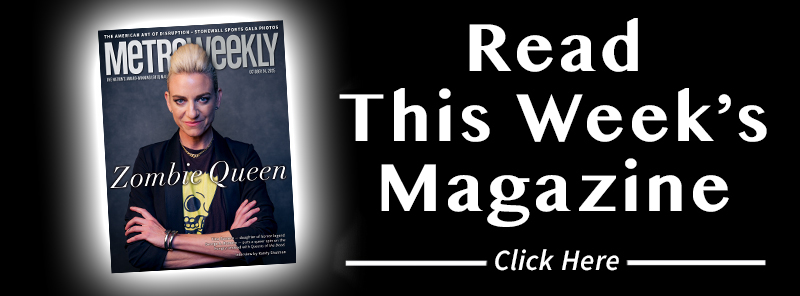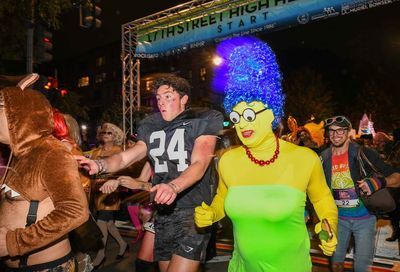The First Homosexuals: How Art Revealed a New Queer Identity
A groundbreaking exhibit at Chicago’s Wrightwood 659 uncovers how visual art helped shape global queer identity between 1869 and 1939.

“The term homosexual was coined in 1869,” says Jonathan D. Katz, the co-curator, along with art historian Johnny Willis, of The First Homosexuals: The Birth of a New Identity, 1869-1939.
“It was actually written originally in a letter between the coiner of the term — a man by the name of [Karl Maria] Kertbeny to Karl Heinrich Ulrichs, the first gay rights campaigner in history. He wrote the first coming out letter and formed the first society for gay rights, and they’re having a big fight because it is Ulrichs who has the argument that homosexuals are a third sex, and it’s Kertbeny who argues that actually every human being alive has the capacity for same sex or different sex desire, that homosexuality is actually a universal human capacity, just like heterosexuality. He says both are universal capacities.
“And he goes on to query, speaking to Ulrichs, ‘Why do you think adopting a minority identity is going to help us? Since when do minorities get civil rights? So instead, you should take this universalist tack.'”
Katz continues, “What we’ve done, of course, is take the universalist language of Kertbeny and weld it onto the minority discourse of Ulrichs and thus overturn the central principles of both their thoughts in this weird amalgam that’s not true to either figure. But what we wanted to do was to create the moment at which the term homosexual, as a minority identity, first gained currency, and take that through World War II.”
The resulting exhibition, which has been on display at Chicago’s Wrightwood 659 since early May and closes on August 2, is an extraordinary collection of art that explores sexuality and sexual identity in every facet imaginable.
Over 300 pieces fill the exhibition space’s three floors — with more than 260 additional images added to a nearly 400-page companion book (“It’s huge. It’s beautiful. It weighs a lot. You should order it by mail because you don’t want to carry it,” he laughs.) — exploring same-sex love, gender fluidity, and how queerness has been an integral, essential, everyday part of world cultures and societies… until it wasn’t.
Katz, a Professor of Practice in Art History and Gender, Sexuality, and Women’s Studies at the University of Pennsylvania, has been working to mount the exhibit for over seven years. He’s known to Washington, D.C. museumgoers for curating the sumptuous LGBTQ exhibit Hide/Seek: Difference and Desire in American Portraiture, which had a run at the Smithsonian’s National Portrait Gallery in late 2010.
The First Homosexuals, however, is a richer, more remarkable exhibit in both breadth and purpose. All the more frustrating that Katz had trouble finding it a home, and is similarly saddened that the exhibit is not traveling the country past its Chicago run. It’s a dismay he willingly shares during our hour-long conversation a few days after the July 4 holiday.
At one point, the 66-year-old gay art historian fumbles his words, and laughs, offering an explanatory apology. “I have a new baby and he’s four months old, and I am really tired, so forgive me for sounding as exhausted as I am.”
But the fact is he doesn’t sound exhausted at all. Talking about the exhibit, and its cultural importance and impact clearly gives him vitality.
“There is one artist who breaks the chronology,” he continues, explaining why the show’s dates were sequestered between 1869 and 1939. “Her name is Toni Ebel, and she was the second successful trans surgery [patient]. And the reason we included her work from the 1950s is that the Nazis destroyed everything before. So they were painted post-war. But we didn’t want to give the Nazis that victory, number one, and number two, because her story is emblematic of where we are.
“Toni Ebel was in love with another trans figure by the name of Charlotte Charlaque, the number three successful trans figure in history,” he continues. “And Charlotte Charlaque was an American of German-Jewish descent who had returned to Germany in the 1920s. In the 1930s, she’s caught up in the anti-Semitic campaign of the Nazis, and she’s put on a transport to a concentration camp to be killed. And somehow Toni Ebel gets on that train and starts arguing with the guards saying, ‘You’ll cause an incident. You can’t arrest her. She’s not German,’ and somehow manages to get her off the train. Immediately the two women hug, and then Charlotte Charlaque goes back to the United States, and they never see each other again. It’s that model of courage and sacrifice that we wanted to leave our visitor with because that’s what these times require.”

METRO WEEKLY: Let’s dive into the exhibit. Why did you choose Wrightwood 659 as the space to show it?
JONATHAN D. KATZ: I’ve done five previous exhibitions at Wrightwood 659, and have always been impressed by their willingness to essentially challenge American museology to do the kinds of exhibitions that other institutions refuse to do. So I brought this to them. And true to form, they were excited about it. They’re a remarkable institution because they seem to have no fear.
MW: When did you bring them the idea?
KATZ: Oh, goodness. I brought it to them seven years ago as a prospect, and then we talked a bit about what it would look like. And, to their credit, they very much insisted that the show be global, which I was thrilled about, because the minute you expand the focus beyond Europe and the United States or North America, you come to understand that the world’s presumptive hostility towards same-sex desire is actually not true at all. For most of the world, same-sex desire and different sex desires comfortably coexisted — even in the same person — and that there just wasn’t the kind of categorical prohibition that the Europeans effectively installed and then carried around the world through colonialism.
MW: The First Homosexuals is a —
KATZ: Provocative title.
MW: Yes, a provocative title, but it’s a revealing title, too. It allows you a framework to keep it from spiraling out of control.
KATZ: Exactly. We really wanted to highlight the beginning of the gulf between homo and hetero. Outside of Europe, there had long been a kind of coexistence of homo and hetero. For example, we have a Japanese scroll from 1850 in the exhibition on the education of a young man — a sexual education. And he is topping women and bottoming to men. It is literally cheek to jowl. He has a homo image, a hetero image, a homo image, a hetero image — all 14 images in the scroll. And this was utterly normative in Japan. The idea that homosexuality was somehow different than heterosexuality never occurred to anybody.
That’s the norm in so many other societies outside of Europe. And what we wanted to do was to chronicle how, in Europe, the notion of the homosexual as a marked difference arose, and what the aftershocks were of that development.
We were particularly interested in how the visual arts can constitute an uncredited but incredibly nuanced archive of forms of sexual difference. Because one of the things that we noticed from the get-go is that as language increasingly became restricted to ultimately two options — homo and hetero — art picked up the slack and became the sphere in which forms of desire — which literally had no language equivalent — could be represented.

MW: So homophobia arose as a result of colonialism, so to speak.
KATZ: Yes. It was the imposition of Western European attitudes on the rest of the world through the vehicle of colonialism. One of the things colonialism did was rewrite indigenous cultures and change the norms.
I’ll give you one example from the exhibition. We have a 1593 text with an illustration by Theodor de Bry that shows the first homophobic incident in the New World, in which the Spanish are siccing dogs on the Cueva — an indigenous tribe that lived in what is today Panama — because they felt that the men were insufficiently manly. The dogs tore them limb from limb — all, of course, in the name of Christ. So that’s the history we’re talking about.
And one of the things that we are able to say with some degree of clarity is that not only was sexuality a problem, but even gender and gender norms were imposed as an aspect of colonialism. We show, for example, a painting of the royal family of Burma, and it is absolutely impossible to ascertain who is male and who is female, based on hair or dress, or the usual signifiers of gender. And that’s because in much of the region — and this includes Thailand and Laos and Cambodia — the notion of gender wasn’t an actual operative distinction. Men and women looked the same and often did the same kinds of work. But the colonials imposed gender as a category. We wanted to show that what we take to be naturalized distinctions are utterly cultural.
MW: It occurs to me that the people who genuinely need to see this exhibit and understand it are so close-minded, they’re not capable of understanding it at all. They’d simply feign shock and disgust.
KATZ: Exactly. Although one of the advantages we have at 659 is that it’s run by a private foundation, so the government can’t close it down — which, under Trump, of course, they would certainly have tried. And for that reason, we also conclude the exhibition by having you walk through the famous photograph of the Nazis burning a library, which is in fact the Institute for Sexual Science — Magnus Hirschfeld’s library, the first queer institute in the world, which was one of the very first targets of the Nazis, because we want to draw an absolutely clear parallel about that moment and our own.

MW: How does the book differ from the exhibit?
KATZ: It differs in the sense that it allows us to reproduce images that we were unable to secure. There are all sorts of reasons, of course, why art isn’t available for loan. But I have never had 90% of my loans refused, and that was the case with this exhibition. And, mind you, the fact that I still had 350 works tells you how rich a vein this is.
But there were no works from, for example, the Muslim parts of the former Soviet Union — so essentially from Kazakhstan down through Azerbaijan, Uzbekistan, all the way to Afghanistan. That region of the world was closed to us. India was closed to us. There were amazing works that were supposed to come in from Slovakia, but then a new government in the Trump model took over and canceled all the loans.
We couldn’t get things from Hungary for obvious reasons, and Russia, for obvious reasons. So there were a lot of front-loaded political considerations.
On the converse side, we had a collector in Colombia who said, “Even though I signed the loan agreement, I am fearful of the fate of my work in the United States under Donald Trump. And so please forgive me, but I’m not going to send the work to you.” They felt that they could no longer trust that the United States would safeguard a work of queer content.
MW: Which is horrible, because we should be the country that you can send something to and expect to get it back safely.
KATZ: Exactly.
MW: You still managed to get 350. So, as you say, there’s a lot out there.
KATZ: There’s a great deal out there. One of the things that we sought to do is to take some of the most celebrated artists and artworks and underscore their hidden queer content. In other instances, we wanted to bring forward artists that no one had ever heard of. We felt that both approaches were warranted.
And further, one of the things that the exhibition really sought to do is to underscore the degree to which queer and trans are joined at the hip. They were born together. They have always been together because, in fact, the earliest definition of homosexuality — not using the term homosexual, that came later — was of a third sex: the ostensible soul of a woman in a man’s body, or conversely, the soul of a man in a woman’s body. You can’t literally think of the early history of queerness without thinking of transness. I don’t know if you saw the most recent opinion piece in the New York Times that talks about how the gay movement has gone astray by virtue of paying attention to transness.
MW: Andrew Sullivan’s piece?
KATZ: Yeah, Andrew’s piece.
MW: I read half of it before tossing it aside in disgust.
KATZ: It’s so ill-informed because it just doesn’t know this history at all. I’m so tired of right-wingers opining when they’re ignorant.
MW: Well, even as a far-left person, I’m incredibly naive and uninformed when it comes to art history. But that’s why I enjoy exploring exhibits like yours — they’re informative and beautiful and emotionally compelling.
KATZ: When we planned this exhibition, it was a different world. And since the election of Trump, it has obviously accrued much deeper and much more powerful significance, in part because the efflorescence of a culture that you can watch through the exhibition develop and bloom is so powerfully cut asunder at the end. We wanted that to be the message of the show.

MW: You must be happy with how it turned out.
KATZ: I am. I mean, of course, curators always think, “If I could have only gotten that painting,” or whatever. But yeah, largely I am, and I’m incredibly grateful to the institutions that did lend to us. And frankly, I was astounded that we got loans from the Musée d’Orsay in Paris, from major, major international collections. This was gratifying because fifteen years ago, frankly, I would never have gotten a loan from the Musée d’Orsay, because the Musée d’Orsay would not have countenanced an exhibition about queerness. But things are changing. Slowly, but they’re changing.
MW: Not fast enough in my opinion, and at times it seems we’re going backwards culturally.
KATZ: I’ve been doing this for close to 40 years. And what I’ve seen is how little things have changed. Here is a huge, comprehensive exhibition stuffed with new scholarly discoveries that no other museum in the United States was interested in, and it is only traveling to Europe in a smaller scale version that’s going to be at the Kunstmuseum Basel [in Switzerland], the only institution that was interested in it. It’s pretty depressing.

MW: What, in your estimation, is keeping museums away from it?
KATZ: One director of a very famous museum said, “It’s exactly the kind of museum exhibition I’d like to show, and therefore the one I can’t show.” I think that’s what we’re seeing — the conjunction of sexuality and art is a third rail. And though it is arguably the case that the art world was perhaps the number one refuge for queer people, the museum world won’t allow this.
And you can see this emblematically even today, even now, when the Art Institute of Chicago takes the show by the impressionist, [Gustave] Caillebotte that had previously been at the Musée d’Orsay and then at the Getty under the title Caillebotte Painting Men. And at the Art Institute of Chicago, in its current incarnation, it’s called Caillebotte: Painting His World. I mean, they changed the title from Painting Men. And that happened a couple of weeks ago. So we are still in a world where they’re terrified. And the director of the Art Institute of Chicago, James Rondeau, is a gay man.
MW: But what are they terrified of? Are they terrified of the Trump administration?
KATZ: I think they’re terrified of their construction of the donor class, because it is, after all, the one percent that call the shots in the American museum world, and they don’t want to do anything that would alienate that one percent. And their assumption is that the one percent are profoundly conservative in order to conserve the very culture that allowed them to climb to the top of the social hierarchy. And while that’s certainly in broad measure probably true, it’s not, of course, uniformly so. I think it’s possible to talk museum boards of directors into supporting progressive exhibitions. But instead, what we get is the same old, same old, same old — and new thought, new ideas, they seem to be almost, by definition, excluded from American museums.
MW: It just seems counterintuitive to the whole idea behind an exhibit in a museum and an expansion of cultural wisdom.
KATZ: And that’s why I’m such a pissed-off queen.
The First Homosexuals: Global Depictions of a New Identity is on view through August 2, 2025, at Wrightwood 659, 659 W. Wrightwood Ave., Chicago. For tickets and information, visit wrightwood659.org.
The companion book, The First Homosexuals: The Birth of a New Identity 1869-1939 (Montacelli Press, 368 pages, $75), will be released on July 16. Available at Wrightwood659.org and Amazon.com.
Discover more queer stories that matter. Subscribe to Metro Weeky’s free digital magazine.
Support Metro Weekly’s Journalism
These are challenging times for news organizations. And yet it’s crucial we stay active and provide vital resources and information to both our local readers and the world. So won’t you please take a moment and consider supporting Metro Weekly with a membership? For as little as $5 a month, you can help ensure Metro Weekly magazine and MetroWeekly.com remain free, viable resources as we provide the best, most diverse, culturally-resonant LGBTQ coverage in both the D.C. region and around the world. Memberships come with exclusive perks and discounts, your own personal digital delivery of each week’s magazine (and an archive), access to our Member's Lounge when it launches this fall, and exclusive members-only items like Metro Weekly Membership Mugs and Tote Bags! Check out all our membership levels here and please join us today!




























You must be logged in to post a comment.